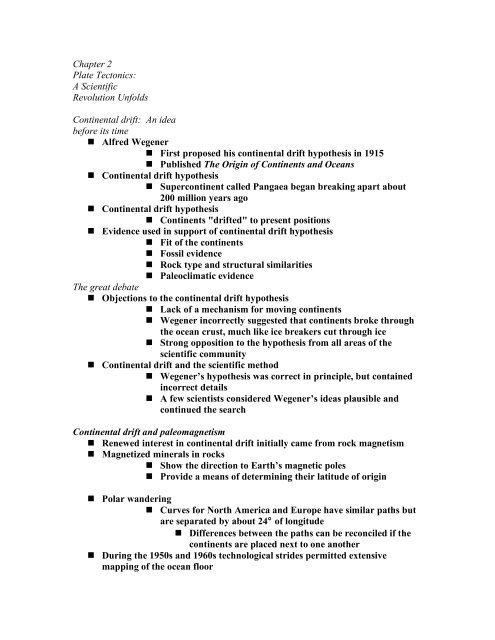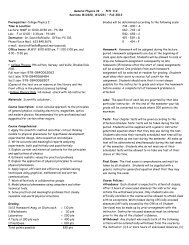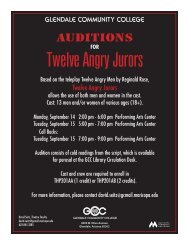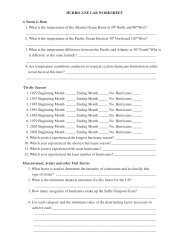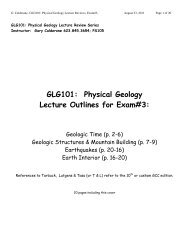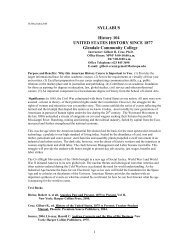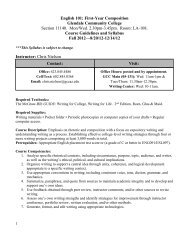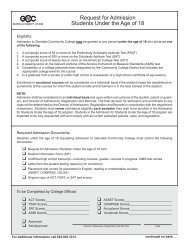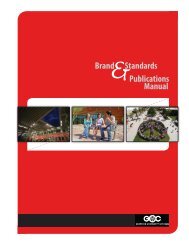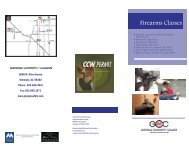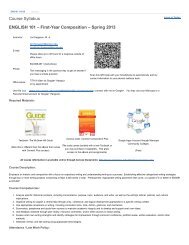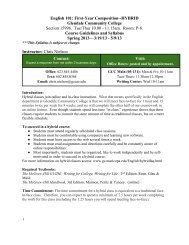Chapter 2 Plate Tectonics: A Scientific Revolution Unfolds ...
Chapter 2 Plate Tectonics: A Scientific Revolution Unfolds ...
Chapter 2 Plate Tectonics: A Scientific Revolution Unfolds ...
Create successful ePaper yourself
Turn your PDF publications into a flip-book with our unique Google optimized e-Paper software.
<strong>Chapter</strong> 2<strong>Plate</strong> <strong>Tectonics</strong>:A <strong>Scientific</strong><strong>Revolution</strong> <strong>Unfolds</strong>Continental drift: An ideabefore its time Alfred Wegener First proposed his continental drift hypothesis in 1915 Published The Origin of Continents and Oceans Continental drift hypothesis Supercontinent called Pangaea began breaking apart about200 million years ago Continental drift hypothesis Continents "drifted" to present positions Evidence used in support of continental drift hypothesis Fit of the continents Fossil evidence Rock type and structural similarities Paleoclimatic evidenceThe great debate Objections to the continental drift hypothesis Lack of a mechanism for moving continents Wegener incorrectly suggested that continents broke throughthe ocean crust, much like ice breakers cut through ice Strong opposition to the hypothesis from all areas of thescientific community Continental drift and the scientific method Wegener’s hypothesis was correct in principle, but containedincorrect details A few scientists considered Wegener’s ideas plausible andcontinued the searchContinental drift and paleomagnetism Renewed interest in continental drift initially came from rock magnetism Magnetized minerals in rocks Show the direction to Earth’s magnetic poles Provide a means of determining their latitude of origin Polar wandering Curves for North America and Europe have similar paths butare separated by about 24° of longitude Differences between the paths can be reconciled if thecontinents are placed next to one another During the 1950s and 1960s technological strides permitted extensivemapping of the ocean floor
Seafloor spreading hypothesis was proposed by Harry Hess in the early1960s Geomagnetic reversals Earth's magnetic field periodically reverses polarity – thenorth magnetic pole becomes the south magnetic pole, and viceversa Dates when the polarity of Earth’s magnetism changed weredetermined from lava flows<strong>Plate</strong> tectonics Earth’s major plates Associated with Earth's strong, rigid outer layer Known as the lithosphere Consists of uppermost mantle and overlying crust Overlies a weaker region in the mantle called theasthenosphere Earth’s major plates <strong>Plate</strong>s move relative to each other at a very slow butcontinuous rate About 5 centimeters (2 inches) per year Cooler, denser slabs of oceanic lithosphere descend intothe mantle <strong>Plate</strong> boundaries Interactions among individual plates occur along theirboundaries Types of plate boundaries Divergent plate boundaries (constructive margins) Convergent plate boundaries (destructive margins) Transform fault boundaries (conservative marginsDivergent plate boundaries Most are located along the crests of oceanic ridges Oceanic ridges and seafloor spreading Along well-developed divergent plate boundaries, the seaflooris elevated forming oceanic ridges Oceanic ridges and seafloor spreading Seafloor spreading occurs along the oceanic ridge system Spreading rates and ridge topography Ridge systems exhibit topographic differences These differences are controlled by spreading rates Continental rifting Splits landmasses into two or more smaller segments along acontinental rift Examples include the East African rift valleys and the RhineValley in northern Europe Produced by extensional forces acting on lithospheric plates
Convergent plate boundaries Older portions of oceanic plates are returned to the mantle in thesedestructive plate margins Surface expression of the descending plate is an ocean trench Also called subduction zones Average angle of subduction = 45° Types of convergent boundaries Oceanic-continental convergence Denser oceanic slab sinks into the asthenosphere Along the descending plate partial melting of mantlerock generates magma Resulting volcanic mountain chain is called acontinental volcanic arc (Andes and Cascades) Types of convergent boundaries Oceanic-oceanic convergence When two oceanic slabs converge, one descends beneaththe other Often forms volcanoes on the ocean floor If the volcanoes emerge as islands, a volcanic island arcis formed (Japan, Aleutian islands, Tonga islands Types of convergent boundaries Continental-continental convergence Continued subduction can bring two continentstogether Less dense, buoyant continental lithosphere does notsubduct Resulting collision between two continental blocksproduces mountains (Himalayas, Alps, AppalachiansTransform fault boundaries <strong>Plate</strong>s slide past one another and no new lithosphere is created or destroyed Transform faults Most join two segments of a mid-ocean ridge along breaks inthe oceanic crust known as fracture zones A few (the San Andreas fault and the Alpine fault of NewZealand) cut through continental crustTesting the model Hot spots and mantle plumes Caused by rising plumes of mantle material Volcanoes can form over them (Hawaiian Island chain) Mantle plumes Long-lived structures Some originate at great depth, perhaps at the mantlecoreboundary
Researchers agree that convective flow in the mantle is the basic drivingforce of plate tectonics Forces that drive plate motion Slab-pull Ridge-push Slab suction Models of plate-mantle convection Any model must be consistent with observed physical andchemical properties of the mantle Models Layering at 660 kilometers Whole-mantle convection Deep-layer modelImportance ofplate tectonics The theory provides explanations for Earth’s major surface processes The geologic distribution of earthquakes, volcanoes, andmountains The distribution of ancient organisms and mineral deposits


